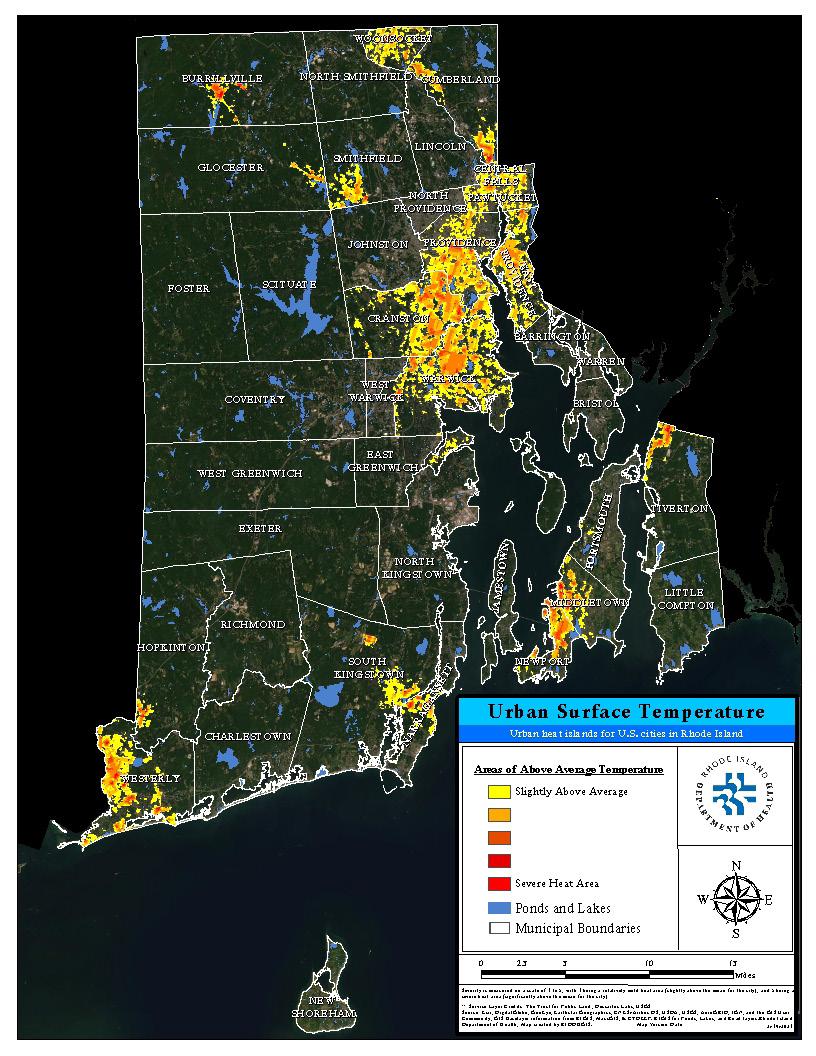
3 minute read
Temperature Map of Rhode Island Master
from Energy, Climate, and You (Rhode Island Edition) Intermediate/Secondary Teacher Guide
by NEED Project
Temperature Map of Rhode Island
Lesson 4 – Climate, Energy, and Society: What Can I Do?
&Background
While students learn about the connections among energy use, climate change, health, and social justice, they will create maps illustrating what they are learning. Students will focus on a specific area, and as a result of their learning choose a health-related issue in their assigned neighborhood(s) and propose one or more solutions addressing it.
Objectives
Students will be able to explain how energy use, climate change, health, and social justice are related. Students will be able to analyze geographical data. Students will be able to identify a problem, analyze it, and propose solutions. Students will be able to present a problem, its analysis, and propose solutions in the presentation. Time
2-3 class periods beyond concurrent work within overall unit
2Preparation Materials
Access to computer with internet Tape measure
Decide the area(s) you will assign for students to investigate. You may choose your own local community and break it into sections, or may decide to choose a community with which your students are not familiar. It may be productive to incorporate a variety of communities or neighborhoods, including those of depressed socioeconomic status and/or higher populations of people of color. Have students work in groups of 3-5, and assign the areas according to the group size and their capabilities. Create or duplicate a map of the area(s) assigned for projection. Pre-select data sites that students will use for constructing their maps. Some suggested websites are listed on page 52. Decide the depth of energy infrastructure you will include in the assignment that students should pull from the EIA website.
Procedure
1. At the beginning of your climate and health unit, introduce this activity and provide students with a sketch, map, or other description of the area they will be studying. Explain to them that this is a project that will run concurrent to the unit and that they will have additional requirements assigned as the unit progresses. 2. Allow students enough time to create a digital map of their assigned area. They can use an online mapping application, overlay digital images, or any other method you wish for them to use. Demonstrate the state energy infrastructure maps on the U.S. EIA website (www.eia.gov) and show them how to select different items to display or remove. 3. As you progress through the unit, assign additional data sets students should add to their maps. Suggest ways they can accomplish this, by adding symbols, or different intensity of shading like darker or lighter red, for example. 4. Assign students a day to go into their assigned communities, where possible, using tools to check for the dimensions of streets, sidewalks, curb heights, and other physical characteristics that may add to or detract from the overall health of their community. 5. Have students use satellite images to find trees and other green spaces in their assigned communities and add them to their maps. 6. When the unit has concluded, and you have had students map as much information as you wish them to consider, have them identify one or two “target” areas where they can indentify potential issues related to the health of the residents of their assigned neighborhoods. 7. Provide time for students to brainstorm solutions to the issues they have identified. 8. Direct students to create a proposal that helps to solve or eliminate the health issue they have identified. Proposals may include posters, essays, video campaigns, multimedia presentations, or formal presentations to community officials.
Extensions
Students may be very motivated to solve all the problems they encounter; tap into that youthful enthusiasm and allow them to pursue a solution to a complex issue as a class. Solutions that are energy-related lend themselves nicely to a student-driven Youth Awards Program project. Encourage students to complete the project. More information can be found at https://www.need.org/need-students/youth-awards/.









